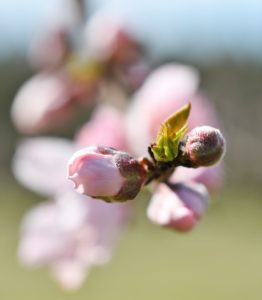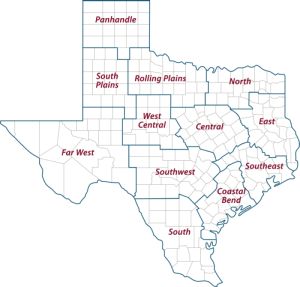Source: AgriLife Today | Feb. 20, 2019 | Weather, crops
Conditions are set for Texas fruit producers to have a bumper year if early blooms can avoid a major freeze before consistent warm weather sets in, said a Texas A&M AgriLife Extension Service expert. Dr. Larry Stein, AgriLife Extension horticulturist, Uvalde, said good chill hours and soil moisture index have fruit trees set up for a good year, but those early blooms could be susceptible to spring freezes.
“It was an awesome chill-hour year,” Stein said. “We have 850-hour peach varieties with active buds starting to swell, and that is good news.”
The bad news could be a strong, late freeze that could kill exposed blooms.
Stein said a light freeze in Central Texas with temperatures dipping to around 27 degrees did not last long enough to cause serious damage.

Buds, like these on a peach tree at Philley Peaches in Overton, are breaking early this year due to plenty of chill hours, sun and warmer temperatures. (Texas A&M AgriLife Extension Service photo by Adam Russell)
“The challenge will be avoiding a serious freeze through mid-March,” he said. “Buds are breaking in some areas, and so we will just have to see what the weather does. Growers are on pins and needles and hoping it will be OK.”
Stein said buds throughout Central Texas are in a variety of stages, from tightly wound buds to blooms. Blooms are most vulnerable to freeze, while tight buds are most cold-hardy.
The wide range of bud stages works to growers’ advantage. Typical fruit trees carry 5,000 to 8,000 blooms that eventually turn into fruit. Producers typically thin those blooms via pruning or physically thinning the crop to around 500 blooms to ensure proper fruit size and quality.
“A light freeze works to their advantage and thins the crop naturally,” he said. “So, they’ll just have to wait out the weather to see.”
Growing conditions are otherwise set up for a good year, Stein said.
“The full soil profile is a good thing and means everything will grow like gangbusters,” he said. “The only thing would be too much rain and at the wrong time.”
Standing water can kill a tree in a matter of days, he said. High moisture levels can also lead to viral and fungal diseases.
Growers should also be prepared to spray tree canopies with a copper hydroxide solution for bacterial leaf spot if wet conditions continue, he said. Fungal diseases like blossom blight and scab are also more prevalent under wet conditions.
Stein said growers should also consider spraying trees with dormant oil to kill scale insects that literally suck the life out of trees.
“Scale insects are the No. 1 killers of fruit trees in Texas,” he said. “It should be a preventative maintenance measure every year just prior to bud break. Trees need total coverage of tree bark and crevices with the spray to kill the insects and their eggs.”
AgriLife Extension district reporters compiled the following summaries:

CENTRAL: Temperatures were warmer. Some parts of the district received 0.5-0.75 of an inch of moisture. Farmers prepared silage corn fields for planting, which was expected to begin soon. Recent rains slowed weed control and fertilization of corn fields. Soil temperatures were still ranging from 45-52 degrees. Other field preparations were ongoing. Orchard plantings were active. Some fruit trees started budding. Some controlled burns were done in hay fields. Livestock were in good condition. Pastures were greening up in parts of the district. Supplemental feed was needed for livestock on rangelands. Wheat and oats looked very good, and rangelands were doing well. Farmers were nearly finished applying nitrogen to wheat. Hay supplies were low, and bale prices remained elevated. Nearly all counties reported good soil moisture. Overall crop, rangeland and pasture conditions were good in nearly all counties.
ROLLING PLAINS: Temperatures fluctuated over the past several weeks, and another cold front was predicted. Some counties reported up to 0.7 of an inch of rain. Winter wheat, pastures and rangeland were in fair to good condition with some greening, but some needed moisture. Livestock were in fair condition with producers feeding supplements as pastures began to play out. Some cotton producers were still trying to finish the cotton harvest.
COASTAL BEND: Soil conditions remained extremely wet in most areas, however, some areas dried out enough to do some fieldwork, including corn and grain sorghum planting. Aerial applications of herbicides were applied in row crop fields that were too wet for fieldwork. Pastures were greening up, and livestock were finding cool-season annuals to consume. Hay and protein supplements continued to be fed. Livestock remained in good condition. Some early peach varieties were blooming.
EAST: Weather patterns continued to improve with high winds drying out some areas. Anderson County producers were able to get a small amount of plowing done on the high areas. Most pastures were still saturated, and fields were too wet for fieldwork. Pastures and rangeland conditions continued to be poor in most counties. Subsoil and topsoil conditions were adequate to surplus. Ponds and creeks were full. Winter forages were starting to emerge in Cherokee, Houston, Panola, Smith, Wood and Sabine counties. Harrison County reported very few winter pastures were fertilized due to wet conditions. Forage growth helped ease hay consumption. Smith County producers were running short on hay supplies. Early spring conditions and adequate soil moisture had producers anticipating a good forage and hay production year. Cattle were in fair to good condition in Anderson and Smith counties, but cattle conditions were declining in Henderson County. The cattle market was stronger in Anderson County and holding steady in Shelby County. Sale numbers were low in Houston County with lower prices on calves 400 pounds or less and higher prices on heavier calves. Wild hogs continued to be destructive in many counties.
SOUTH PLAINS: Conditions were extremely dry and windy. Winds were 20-30 miles per hour almost every day with gusts up to 70 miles per hour. Conditions were drying out very rapidly. High winds also hindered some field work, especially spraying. Unseasonably high temperatures were mixed with cold snaps. Cold temperatures and moisture were forecasted. Winter wheat, pastures and rangelands were in fair to good condition.
PANHANDLE: Conditions were dry with no moisture in the forecast. Winter wheat conditions were holding on in some counties, but producers reported most pastures were in poor condition. Cattle on wheat pasture were running out of forage quickly. Native pastures were grazed heavily.
NORTH: Soil moisture was adequate to surplus across the district. Temperatures were up and down, but mostly cold and wet. Counties reported another inch or more of rain, so fields and pastures were wet. Early planted winter pastures looked decent. Saturated soils, freezing temperatures and very little sunshine were hindering growth. Thistle rosettes were popping up. Producers unable to fertilize were looking for an opportunity. Many producers were putting more stocker calves on wheat than pastures could support because more growth was anticipated. Producers were feeding lots of hay, but supplies were very short. Cows were in decent shape, but some were declining and in poor condition. Many herds were calving, so even more hay was needed. Hay consumption was expected to rise unless winter pastures take off soon, and typical spring green-up was still several weeks away.
FAR WEST: Daytime temperatures were mostly in the 80s with morning lows in the 20s. No measurable rain was received, and conditions were windy. Producers were preparing fields for planting. Pre-emergent applications were needed. Producers were watering pecan trees. Pheromone traps for pecan nut casebearer were expected to be put out soon. Some producers were feeding supplements to cattle.
WEST CENTRAL: Weather was both cold and wet and then turned warm. Wheat was growing well with the warm days and nights. Fields were prepared for spring planting. Pastures were green with winter grasses and forbs. Cattle demand was strong with a very active market on choice calves and yearlings. Light stocker steers sold steady and light stocker heifers sold $5 higher per hundredweight. Calves 500-650 pounds were also $5 higher per hundredweight. Feeder steers were $3 higher per hundredweight, and feeder heifers and bulls were steady. Packer cows were $1-$2 higher per hundredweight.
SOUTHEAST: Wet conditions persisted. Livestock were in fair to good condition. Sunshine and wind helped dry saturated fields in Brazos County, but the ground in Jefferson County was still too wet for field work. Plantings were expected to be delayed until the first or second week of March due to wet conditions, especially if forecasted rain materializes. In Grimes County, pastures and rangelands continued to struggle because of too much moisture. Rangeland and pasture ratings were fair to very poor with fair being most common. Soil-moisture levels ranged from adequate to surplus with surplus being most common.
SOUTHWEST: Some parts of the district were reporting warm weather and sunshine with improving rangeland and pasture conditions. Other counties experienced cold and rainy days, fog and decreased rangeland and pasture conditions. Soil needed to dry for corn planting. Summer grasses were greening up. Producers were providing supplemental feed to livestock.
SOUTH: Northern and western parts of the district reported mild weather with short to adequate soil moisture levels. Temperatures were around 70 degrees during the day and 40 degrees during nights. Southern and eastern parts of the district reported cool weather and adequate soil moisture. The southern parts reported sporadic rain and up to half an inch in some areas. No moisture was reported in other parts. Potato planting continued. Wheat fields were under irrigation and continued to be in good condition. Pasture and rangeland conditions were poor in some areas due to lack of rainfall but were good in areas with adequate soil moisture. Supplemental feeding of cattle was steady. Body condition scores on most herds were fair, and spring calving activity picked up momentum. Coastal Bermuda grass remained dormant. Onions and carrots made good progress. Cabbage and spinach harvest were very active. Field activity was steady with farmers applying fertilizer in preparation of planting season. Producers were preparing fields for corn, sorghum and cotton. There were a few reports continuing to trickle in of corn and sunflowers being planted, but no emergence. Ginning of cotton remained active. Some landowners were implementing prescribed burns to clear old growth and stimulate new forage as weather conditions allow.
